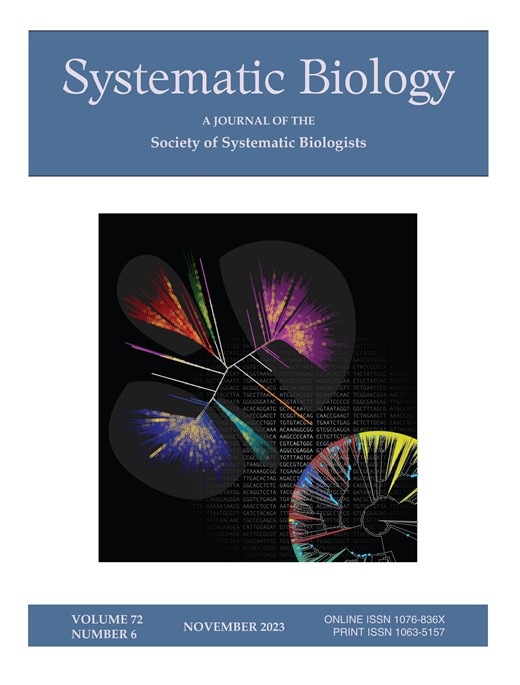利用AIC选择全基因组比对系统发育分析的窗口大小
IF 5.7
1区 生物学
Q1 EVOLUTIONARY BIOLOGY
引用次数: 0
摘要
基因树的不一致性对系统基因组学方法识别非重组区域和重建每个区域的系统发育树提出了挑战。为了解决这个问题,许多研究使用了非重叠窗口方法,通常是任意选择固定窗口大小,可能包括窗口内重组事件。在这项研究中,我们提出了一种信息理论方法来选择最能反映对齐潜在历史的窗口大小。首先,我们模拟了反映经验数据集关键特征的染色体比对,并发现AIC在正确恢复染色体比对的树拓扑结构方面是一个很好的窗口大小精度预测器。为了解决经验数据集中缺失数据的问题,我们设计了一种逐步非重叠窗口方法,该方法一次比较两个窗口大小的AIC,只保留可以使用两个窗口大小进行分析的基因组区域。然后,我们将这种方法应用于蝴蝶和类人猿的基因组。我们发现蝴蝶染色体的最佳窗口大小在125bp到250bp之间,这比之前研究中使用的要短得多,尽管这种窗口大小的差异并没有显著改变基因组中最常见的拓扑结构。另一方面,类人猿染色体的最佳窗口大小在500bp到1kb之间,主要拓扑结构(人类和黑猩猩分组)的比例在60%到87%之间,与先前的发现一致。此外,我们观察到分别使用小窗口和大窗口时基因树估计误差和连接的显着影响。例如,当使用250bp的窗口时,类人猿的主要拓扑比例为50%,但对于64kb的窗口,这一比例几乎达到100%。总之,我们的研究强调了在非重叠窗口分析中选择固定窗口大小的挑战,并提出AIC是在全基因组比对中运行非重叠方法时选择最佳窗口大小的一种不那么任意的方法。本文章由计算机程序翻译,如有差异,请以英文原文为准。
Selecting a Window Size for Phylogenomic Analyses of Whole Genome Alignments using AIC
Gene tree discordance along a set of aligned genomes presents a challenge for phylogenomic methods to identify the non-recombining regions and reconstruct the phylogenetic tree for each region. To address this problem, many studies used the non-overlapping window approach, often with an arbitrary selection of fixed window sizes that potentially include intra-window recombination events. In this study, we propose an information theoretic approach to select a window size that best reflects the underlying histories of the alignment. First, we simulated chromosome alignments that reflected the key characteristics of an empirical dataset and found that the AIC is a good predictor of window size accuracy in correctly recovering the tree topologies of the alignment. To address the issue of missing data in empirical datasets, we designed a stepwise non-overlapping window approach that compares the AIC of two window sizes at a time, retaining only genomic regions that can be analysed using both window sizes. We then applied this method to the genomes of Heliconius butterflies and great apes. We found that the best window sizes for the butterflies’ chromosomes ranged from <125bp to 250bp, which are much shorter than those used in a previous study even though this difference in window size did not significantly change the most common topologies across the genome. On the other hand, the best window sizes for great apes’ chromosomes ranged from 500bp to 1kb with the proportion of the major topology (grouping human and chimpanzee) falling between 60% and 87%, consistent with previous findings. Additionally, we observed a notable impact of gene tree estimation error and concatenation when using small and large windows, respectively. For instance, the proportion of the major topology for great apes was 50% when using 250bp windows, but reached almost 100% for 64kb windows. In conclusion, our study highlights the challenges associated with selecting a fixed window size in non-overlapping window analyses and proposes the AIC as a less arbitrary way to select the optimal window size when running non-overlapping method on whole genome alignments.
求助全文
通过发布文献求助,成功后即可免费获取论文全文。
去求助
来源期刊

Systematic Biology
生物-进化生物学
CiteScore
13.00
自引率
7.70%
发文量
70
审稿时长
6-12 weeks
期刊介绍:
Systematic Biology is the bimonthly journal of the Society of Systematic Biologists. Papers for the journal are original contributions to the theory, principles, and methods of systematics as well as phylogeny, evolution, morphology, biogeography, paleontology, genetics, and the classification of all living things. A Points of View section offers a forum for discussion, while book reviews and announcements of general interest are also featured.
 求助内容:
求助内容: 应助结果提醒方式:
应助结果提醒方式:


